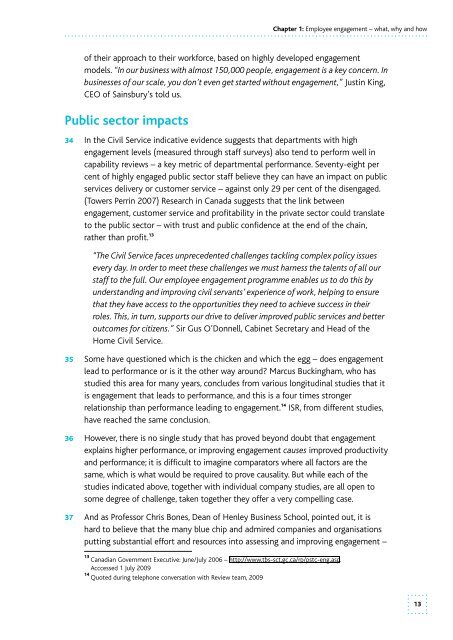3ytgeaf
3ytgeaf
3ytgeaf
You also want an ePaper? Increase the reach of your titles
YUMPU automatically turns print PDFs into web optimized ePapers that Google loves.
Chapter 1: Employee engagement – what, why and how<br />
of their approach to their workforce, based on highly developed engagement<br />
models. “In our business with almost 150,000 people, engagement is a key concern. In<br />
businesses of our scale, you don’t even get started without engagement,” Justin King,<br />
CEO of Sainsbury’s told us.<br />
Public sector impacts<br />
34 In the Civil Service indicative evidence suggests that departments with high<br />
engagement levels (measured through staff surveys) also tend to perform well in<br />
capability reviews – a key metric of departmental performance. Seventy-eight per<br />
cent of highly engaged public sector staff believe they can have an impact on public<br />
services delivery or customer service – against only 29 per cent of the disengaged.<br />
(Towers Perrin 2007) Research in Canada suggests that the link between<br />
engagement, customer service and profitability in the private sector could translate<br />
to the public sector – with trust and public confidence at the end of the chain,<br />
rather than profit. 13<br />
“The Civil Service faces unprecedented challenges tackling complex policy issues<br />
every day. In order to meet these challenges we must harness the talents of all our<br />
staff to the full. Our employee engagement programme enables us to do this by<br />
understanding and improving civil servants’ experience of work, helping to ensure<br />
that they have access to the opportunities they need to achieve success in their<br />
roles. This, in turn, supports our drive to deliver improved public services and better<br />
outcomes for citizens.” Sir Gus O’Donnell, Cabinet Secretary and Head of the<br />
Home Civil Service.<br />
35 Some have questioned which is the chicken and which the egg – does engagement<br />
lead to performance or is it the other way around Marcus Buckingham, who has<br />
studied this area for many years, concludes from various longitudinal studies that it<br />
is engagement that leads to performance, and this is a four times stronger<br />
relationship than performance leading to engagement. 14 ISR, from different studies,<br />
have reached the same conclusion.<br />
36 However, there is no single study that has proved beyond doubt that engagement<br />
explains higher performance, or improving engagement causes improved productivity<br />
and performance; it is difficult to imagine comparators where all factors are the<br />
same, which is what would be required to prove causality. But while each of the<br />
studies indicated above, together with individual company studies, are all open to<br />
some degree of challenge, taken together they offer a very compelling case.<br />
37 And as Professor Chris Bones, Dean of Henley Business School, pointed out, it is<br />
hard to believe that the many blue chip and admired companies and organisations<br />
putting substantial effort and resources into assessing and improving engagement –<br />
13<br />
Canadian Government Executive: June/July 2006 – http://www.tbs-sct.gc.ca/rp/pstc-eng.asp.<br />
Acccessed 1 July 2009<br />
14<br />
Quoted during telephone conversation with Review team, 2009<br />
13


